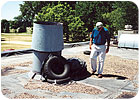
It is the experience of most building owners and property managers that roofs of commercial facilities, particularly in temperate climates and those having a low slope, are a chronic problem.
The most visible of all roof-related problems is moisture intrusion into the facility -- i.e., the roof leak. Roof leaks do not necessarily indicate total roof system failure. They indicate that there is a failure point within the system. That failure point must be corrected prior to extensive damage to the roof as a system. The extent of the damage to the components of the system caused by the leak will have a greater bearing on the overall system failure. For example, a split in a roofing membrane amounts to immediate failure to protect the building’s structure and its contents, as does a flashing failure, detachment due to wind forces, mechanical damage by man, or any change in the protective function of the roofing membrane.

The Roof as a System
The important fact to consider is that there exists a distinct synergism in the dysfunction of a roofing system. In simple terms, when one part of a roof system fails, the rest of the “pieces” of that system will eventually fail as well.To determine if the roof system has failed, it is important to analyze the entire system. Regardless of the membrane covering, all roof systems are comprised of similar components. The materials for the components are the only variations. The roof system components include:
- Structural deck (substrate).
- Insulation.
- Membrane.
- Surfacing.
- Flashings.
- Metal terminations.
What to Look For
Obviously, the intent of the roof inspection is to identify roof defects that will have an adverse affect on the service life of the roof system. These defects can be in the form of openings, holes and splits to the membrane or flashing systems. The inspector should also be cognizant of extensive debris on the roof surface. Debris can be detrimental to the roof system in a variety of conditions. Debris may clog roof drains, impeding proper drainage. Certain types of debris can also puncture the membrane flashing.While complex repairs and some maintenance items should be performed by qualified roofing professionals, the owner or building maintenance manager can assist in the maintenance of the roof by performing regular housekeeping duties, such as cleaning all debris from the roof area.
Each type of roof membrane system has its own unique distress indicators and failure modes. There are certain distress indicators that are common to all roof systems. When inspecting a roof, two areas in particular deserve special attention: the roof’s perimeter and the roof membrane.
The Roof's Perimeter
The perimeter of a roof has many components that can become faulty, contributing to the potential for roof-system failure. When doing a roof inspection, the inspector should pay particular attention to the following areas:- Metal gravel stops, applied at the roof edge, can show defects if improperly designed and secured, and can move, creating openings at the metal gravel stop joints. Distress can also occur at points where the metal gravel stop is applied over the roof membrane.
- Expansion joints constructed of elastomeric materials are susceptible to splits, punctures, holes and openings.
- Flashings on a roof are susceptible to blistering, ballooning, buckling, and cracks or splits. Flashings can also show wear due to insufficient maintenance. In addition, defective flashing conditions can occur in the location of mechanical units. All of these scenarios can lead to roof-system failure.
- Rooftop equipment, such as HVAC units or exhaust pipes, can be a primary source of problems, particularly at flashing seams. Chemical discharge from certain rooftop equipment can quickly degrade a roof membrane. The equipment discharge must be controlled with proper design and maintenance programs.
Problems with Roof Membranes
The roof membrane can also be compromised, potentially causing roof leaks and other problems. The building owner or maintenance supervisor should first make sure that the roof system has been applied properly by a licensed, qualified roofing contractor. However, even when the roof system is applied properly, the membrane can fail due to the following circumstances:- Blisters, ridges or bare areas in the roof membrane can compromise the roof system’s performance. Cracks in the membrane can often occur as a result, allowing moisture into the system and the facility.
- Ponding areas or excessive wear in certain areas can lead to structural damage to the roof system and leaks.
- Plant growth on the roof surface, which sometimes occurs in the areas of chronic ponding conditions, and the accumulation of dust and organic airborne contaminants can also cause damage to the membrane.
- Punctures in the membrane allow for moisture intrusion into the membrane and the facility. Common causes of punctures include broken blisters, fasteners backing out of the substrate, dropped tools or other dropped objects, hail, lack of proper membrane support, or mechanical abuse.
- Plugged drains caused by debris, abuse, incorrect or marginal design, or insufficient maintenance can lead to improper drainage and chronic ponding problems.
You may also want a professional roofing consultant to inspect your roof to get an unbiased opinion of your roof system’s potential problems.
Either way, a little regular inspection and maintenance of a building’s roof will help to eliminate major problems, as well as the costs associated with those problems.

Report Abusive Comment